I M P O R T A N T – F I R S T
✓ The annual energy storage market installed capacity in the United States is expected to reach 28.3GWh in 2023, and the energy storage market is expected to increase to 44.2GWh and 68.2GWh in 2024-2025
✓ It is estimated that the newly installed capacity of large-scale storage in the United States is expected to reach 24-25GWh in 2023, a significant increase from 12.2GWh in 2022 (including all energy storage types)
✓ It is expected that the installed energy storage capacity in Europe will reach 11.3/18.3/26.4GWh from 2023 to 2025, with a CAGR of 53% from 2021 to 2025.
✓ Europe | Household savings: 5.7GWh of new installed capacity will be added in 2022, 147.6% year-on-year
✓ On the front-meter energy storage side of Europe, 2GW of newly installed capacity will be installed in 2022, accounting for 44%, and has begun to take shape. Among them, the UK accounts for 42%, leading the European large storage market.
Europe and the United States are mature markets, and manufacturers are flocking to them. However, the barriers to product certification and grid connection experience, funds, channels, customers and brands are becoming increasingly high, and small companies will be deterred.
US Energy Storage Market
According to the latest U.S. energy storage monitoring report released by the American Clean Energy Council (ACP) and Wood Mackenzie, in 2022, the U.S. will install 4,798MW/12,181MWh of new energy storage capacity, a year-on-year increase of 34%/12%; U.S. energy storage installed capacity is expected to increase from 2023 to 2025 The capacity will reach 28.3/44.2/68.2GWh.
Installed capacity by application scenario in the United States in 2022Q1 and 2023Q1
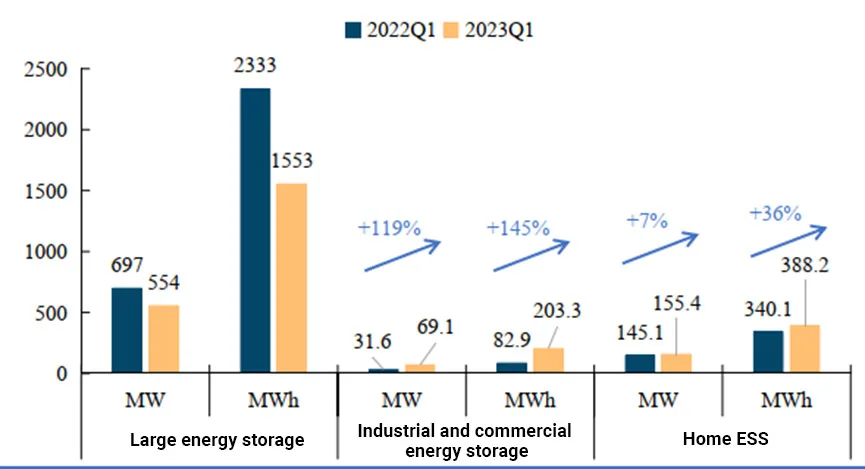
It is estimated that the newly installed capacity of large-scale storage in the United States is expected to reach 24-25GWh in 2023, a significant increase from 12.2GWh in 2022 (including all energy storage types).
✓ Installed capacity: The installed capacity of energy storage systems will reach 0.88GW/1.11GWh in 2022
As of the end of 2022, the installed capacity of utility-scale battery energy storage systems (BESS) operating in the United States reached 8842MW/11105MWh. Among them, most of the BESSs operating in 2022 were installed after 2014, with approximately 4807MW installed in 2022 alone, accounting for 54.4%; the single BESS capacity already in operation has increased from less than 1 MW to the Manatee Solar Energy Center in Florida. of 409 MW, the center started operations in November 2021.
Battery energy storage installed capacity in the United States from 2010 to 2022:

As of 2022, there are a total of 39 states with utility-scale BESS in the United States. Among them, California, Texas and Florida have the largest installed capacity, accounting for more than 80%.
✓ Regional power grids in the United States are independent of each other, and energy storage assists large-scale cross-regional dispatch
The U.S. energy storage market has obvious regional differentiation, mainly concentrated in California and Texas. As of 2021, California’s energy storage installed capacity is 2339.1MW, accounting for 44%; Texas’s energy storage installed capacity is 797.4MW, accounting for 15%. The rapid development of California and Texas is mainly related to factors such as unstable power infrastructure and obvious policy incentives.
U.S. energy storage is currently mainly composed of three major power grid groups: Eastern United Power Grid, Western United Power Grid and Texas Power Grid. The three major power grids are relatively independent. Since UHV technology has not been widely used in the United States, and the distance is too long and the losses are too great, power grid groups are unwilling to carry out interstate transmission. Therefore, they operate independently, making it difficult to carry out large-scale cross-regional dispatch. Therefore, power auxiliary services are needed to help complete consumption, and the installed capacity of energy storage on the power generation side and the grid side has increased significantly.
✓ The installed capacity of the energy storage market is expected to reach 28.3GWh in 2023
At present, the United States has taken a number of measures to clear the backlog of grid-connected projects, which are expected to be implemented in the next 2-3 years. The energy storage market is expected to increase to 44.2GWh and 68.2GWh in 2024-2025, with a CAGR of 59.5% from 2021-2025.
U.S. energy storage market space estimation:

EU Energy Storage Market
For European market, the household savings are still hot, and large-scale savings are about to start
✓ Europe | Household savings: 5.7GWh of new installed capacity will be added in 2022, 147.6% year-on-year
According to data from the European Photovoltaic Association and EV tank, in 2022, the newly installed capacity of household storage in Europe will be approximately 5.7GWh, +147.6% year-on-year; the cumulative installed capacity will be 11.1GWh, +105.2% year-on-year. Germany, Italy, the United Kingdom, and Austria ranked the top four markets with 1.54GWh, 1.1GWh, 0.29GWh, and 0.22GWh respectively. As the two countries with the largest household storage installed capacity in Europe, Germany and Italy will account for more than 50% of the total installed capacity in 2022. Among them, Germany will have more than 1GW of household storage installed capacity, and more than 200,000 households will choose to install household energy storage systems in 2022; Italy The installed capacity of household storage exceeds 500MW, but with the gradual reduction of the Superbonus subsidy policy (completely phased out in 2026), the demand for household storage in Italy will gradually weaken in the future.
New household storage installed capacity in Europe (MWh) and year-on-year (%):
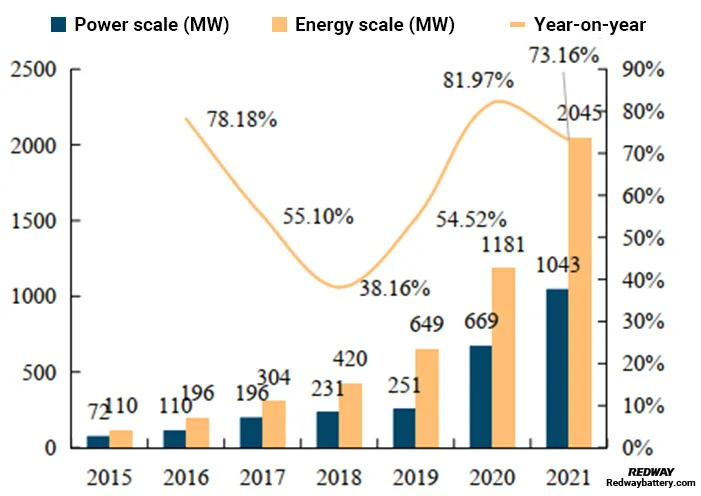
Proportion of new household storage installed capacity in Europe from 2020 to 2022 (%):
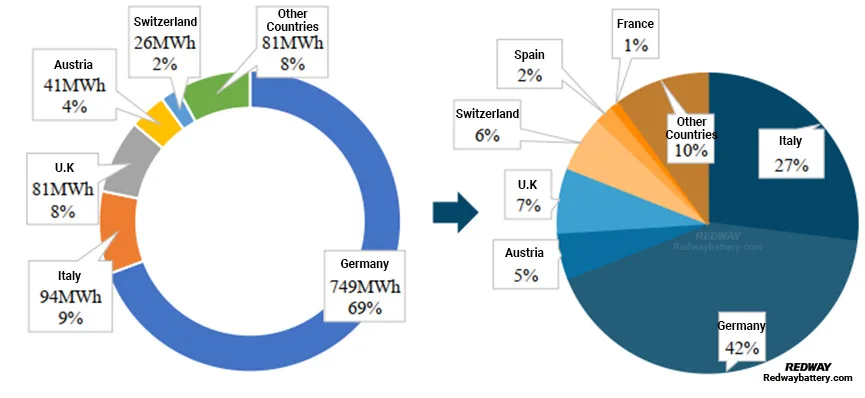
✓ Large storage: On the front-meter energy storage side of Europe, 2GW of new installed capacity will be added in 2022, accounting for 44%, and it has begun to take shape; multi-country plans will drive future volume
Among them, the UK accounts for 42%, leading the European large storage market. In July 2023, the European electricity reform plan was passed. Many countries have established capacity markets, the revenue model is gradually improving, and the large storage market has support points. It is expected that the installed energy storage capacity in Europe will reach 11.3/18.3/26.4GWh from 2023 to 2025.
As the cost of photovoltaic storage decreases in 2023, ground photovoltaics and large-scale storage in Europe will gradually open up the market, and the project scale of energy storage projects will continue to increase. The European large storage market has begun to take shape. According to data from the European Energy Storage Association (EASE), Europe’s newly installed energy storage capacity will be approximately 4.5GW in 2022, of which large storage capacity will be 2GW, accounting for 44% of the power scale. From the perspective of the installed capacity of energy storage in front of the meter, the UK market accounts for 42%, leading the European large storage market. Ireland, Germany, and France account for 16%, 12%, and 11% of installed capacity respectively. EASE predicts that new large energy storage capacity in Europe will be at least 3.5GW in 2023.
According to Wood Mackenzie’s forecast, by 2031, the cumulative installed capacity of large storage in Europe will reach 42GW/89GWh, with the United Kingdom, Italy, Germany, Spain and other countries leading the large storage market. The growth of renewable energy installed capacity and the gradual improvement of revenue models are driving the development of large-scale storage in Europe.
Forecast of cumulative new installed capacity in Europe’s Top 10 grid-level energy storage markets from 2022 to 2031:
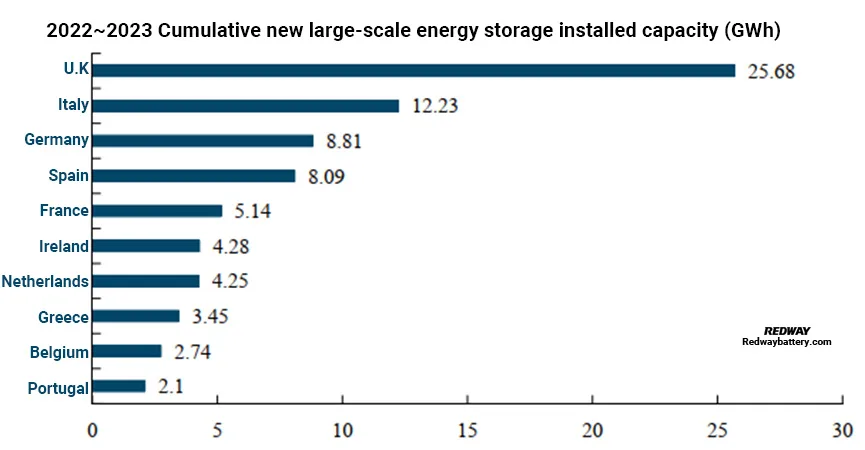
Energy storage trends in EU storage markets in recent years
Europe
On July 19, 2023, the European Parliament passed the power reform plan to encourage the power grid to introduce more non-fossil fuel flexible resources (such as energy storage, demand side response), and improve investment returns through capacity markets and other methods.
U.K
In 2020, the 50MW capacity limit for a single battery energy storage project will be officially removed, significantly shortening the approval cycle for large storage, and at the same time canceling the dual charging mechanism for energy storage on the generation/consumption side. DR and DM services were launched in 2022.
Italy
Regulators approve new grid-scale energy storage auction rules. Terna said around 94GWh of energy storage will be needed to integrate planned renewable energy in Italy. Research firm LCP Delta predicts that 800-900MW of energy storage will be deployed in 2023-2024, second only to the UK in scale.
Spain
The government plans to fund 160 million euros to deploy 600MW energy storage projects that will be connected to the grid in 2026. State aid of 280 million euros will be launched in July 2023 to support independent energy storage projects and pumped storage hydropower projects.
Germany
In 2020, the “innovative bidding” was launched for the first time to assist the implementation of energy storage and other renewable energy projects. At present, Germany’s large storage units are small in scale, with about 77% of large storage projects having a capacity of less than 10MWh.
Greece
A large-scale battery storage auction has been approved by Greek regulators. The independent energy storage procurement process will start in Q3 2023, and the system will be completed by the end of 2025.
✓ Europe | Future Outlook: Installed capacity will reach 11.3GWh in 2023, CAGR will reach 53% from 2021 to 2025
After Russia restricted gas supplies in 2021, Europe began switching from gas to coal. At present, electricity prices in many European countries are still higher than before the Russia-Ukraine conflict, and the fundamentals of electricity have not improved. Europe, as a mature market for household savings, will remain hot. In addition, the power supply levels of European hydropower vary greatly between dry and wet periods, and the dependence on wind and solar power generation is gradually increasing.
The large-scale storage market will have an installed capacity of 2GW in 2022, which has begun to take shape; in July 2023, after the European power reform plan is passed, the large-scale storage market will have the momentum to start volume. From 2023 to 2025, the newly installed energy storage capacity will reach 11.3GWh, 18.3GWh, and 26.4GWh.
European energy storage market space calculation:
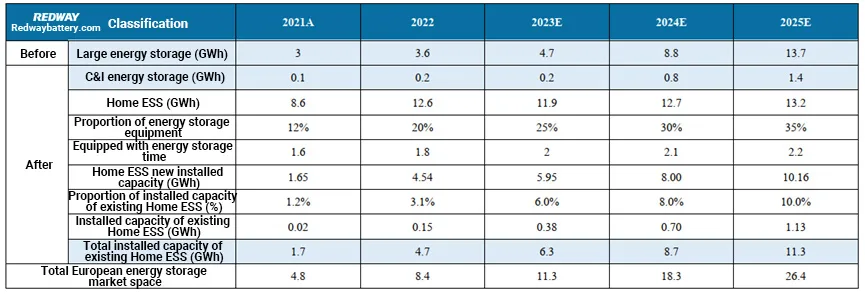
Thank you for reading.


